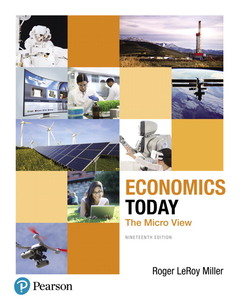Description
Economics Today (19th Ed.)
The Micro View
Author: Miller Roger
Language: English
Subject for Economics Today:
Approximative price 264.10 €
In Print (Delivery period: 14 days).
Add to cart544 p. · 22x27.5 cm · Paperback
Description
/li>Contents
/li>Comment
/li>
Economics brought to life through real-world application
Readers learn best when they see concepts applied to examples from their everyday lives, so Economics Today: The Micro View addresses real, cutting-¿edge issues while facilitating individual learning. The text shows readers how economics is front and center in their daily routines, while providing them with many ways to evaluate their understanding of key concepts covered in each chapter. The 19th Edition also includes a new emphasis on behavioral economics, along with all-new problems, vignettes, and features that engage readers and help them focus on the central ideas in economics today.
Also available with MyLab Economics
MyLab? Economics is an online homework, tutorial, and assessment program designed to work with this text to engage students and improve results. Within its structured environment, students practice what they learn, test their understanding, and pursue a personalized study plan that helps them better absorb course material and understand difficult concepts.Note: You are purchasing a standalone product; MyLab Economics does not come packaged with this content. Students, if interested in purchasing this title with MyLab Economics, ask your instructor for the correct package ISBN and Course ID. Instructors, contact your Pearson representative for more information.
0134641744 / 9780134641744 Economics Today: The Micro View Plus MyLab Economics with Pearson eText -- Access Card Package
Package consists of:
- 0134479254 / 9780134479255 Economics Today: The Micro View
- 0134480333 / 9780134480336 MyLab Economics with Pearson eText -- Access Card -- for Economics Today: The Micro View
PART 1: Introduction
1. The Nature of Economics
2. Scarcity and the World of Trade-Offs
3. Demand and Supply
4. Extensions of Demand and Supply Analysis
5. Public Spending and Public Choice
6. Funding the Public Sector
PART 5: Dimensions of Microeconomics
19. Demand and Supply Elasticity
20. Consumer Choice
21. Rents, Profits, and the Financial Environment of Business
PART 6: Market Structure, Resource Allocation, and Regulation
22. The Firm: Cost and Output Determination
23. Perfect Competition
24. Monopoly
25. Monopolistic Competition
26. Oligopoly and Strategic Behavior
27. Regulation and Antitrust Policy in a Globalized Economy
PART 7: Labor Resources and the Environment
28. The Labor Market: Demand, Supply, and Outsourcing
29. Unions and Labor Market Monopoly Power
30. Income, Poverty, and Health Care
31. Environmental Economics
PART 8: Global Economics
32. Comparative Advantage and the Open Economy
33. Exchange Rates and the Balance of Payments
About the book
- NEW! and EXPANDED! Emphasis on Behavioral Economics. The theory of bounded rationality forms the basis of behavioral economics. This theory is expanded upon in the introductory chapter and a number of micro chapters. More importantly, in keeping with the desire to show the applicability of theory, every single chapter in the 19th edition has a behavioral economics example.
- NEW! End-of-Chapter Problems. There are six to eight new problems at the end of each chapter, many of which are based on the interactive graphs within the chapter. They require students to apply their critical thinking skills learned from the chapter.
- NEW! An opening vignette about a serious application of each chapter’s theory with a continuing Issues & Applications feature at the end of every chapter is new to this edition.
- Learning Objectives accompany each major chapter section to help focus student reading comprehension and allow for self-assessment to ensure that students have grasped key concepts.
- NEW! A “grabber” Did You Know Thatfeature starts off every chapter.
- NEW! A variety of examples are classified into three categories, and each has three references from which the information was obtained:
- Example
- Policy Example
- Behavioral Example
- International Example
- NEW! What If features are included in each chapter.
- NEW! You Are There features demonstrate to students how real people react to policy changes and changes in our economic environment.
- Domestic topics and events are presented through thought¿-provoking discussions.
- Important policy questions help students understand public debates.
- Global and international policy examples emphasize the continued importance of international perspectives and policy.




